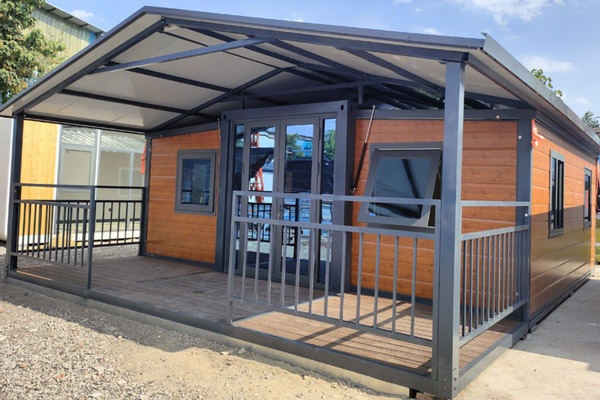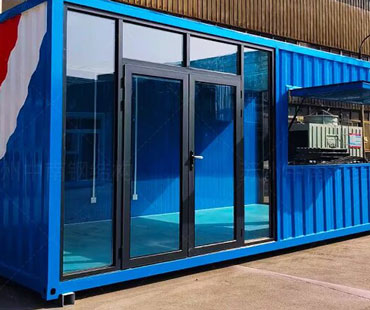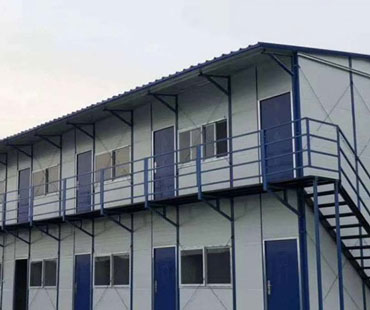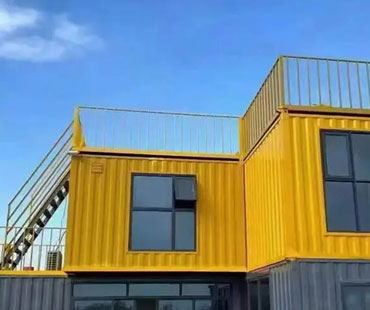Natural disasters, such as earthquakes, floods, and hurricanes, have devastating impacts on communities around the world. In the aftermath of such events, the urgent need for temporary and permanent housing solutions becomes paramount. Traditional construction methods often fall short due to time constraints, high costs, and the logistical challenges of rebuilding infrastructure. In this context, container houses have emerged as a viable and innovative solution for post-disaster reconstruction.
Container houses are structures made from repurposed shipping containers. These containers are designed for durability and strength, making them an ideal material for building homes. They can be modified to include insulation, plumbing, and electrical systems, transforming them into fully functional living spaces. The modular nature of container houses allows for easy stacking and arrangement, enabling architects and builders to create diverse housing layouts that meet the needs of different communities.
Advantages of Container Houses in Post-Disaster Reconstruction
1.Speed of Construction
One of the most significant advantages of container houses is the speed with which they can be deployed. Unlike traditional construction, which can take months or even years, container houses can be assembled and occupied within days. This rapid deployment is crucial in disaster scenarios where victims need immediate shelter and support.
2.Cost-Effectiveness
Container houses are often more affordable than conventional building methods. The cost of used shipping containers is relatively low, and the materials can be sourced locally to further reduce expenses. Additionally, the reduced construction time translates to lower labor costs, making container houses an economically feasible option for both governments and humanitarian organizations engaged in disaster relief.
3.Sustainability
The use of shipping containers in construction promotes sustainability by repurposing materials that would otherwise go to waste. This not only reduces the environmental impact of construction but also supports the concept of circular economy. Furthermore, container houses can be designed with energy-efficient features, such as solar panels and green roofs, to minimize their ecological footprint.
4.Mobility and Flexibility
Container houses are inherently portable, which adds an extra layer of flexibility in post-disaster scenarios. They can be easily transported to different locations as needed, allowing for temporary housing solutions that can be relocated as communities begin to rebuild. This mobility is particularly beneficial in areas where infrastructure has been severely damaged, as it allows for housing solutions to be deployed quickly to the most affected zones.
5.Modular Design and Customization
Container houses offer a modular design that allows for easy customization and expansion. Multiple containers can be combined to create larger living spaces, communal facilities, or even entire neighborhoods. This flexibility accommodates various family sizes and community needs, making it easier to provide adequate shelter for diverse populations affected by disasters. Additionally, interior layouts can be adapted to include essential amenities such as kitchens, bathrooms, and living areas, ensuring that residents have comfortable and functional living environments.

Applications in Post-Disaster Scenarios
1.Emergency Shelters
Immediately following a disaster, container houses can serve as emergency shelters for displaced individuals and families. Their quick assembly and transportability make them ideal for providing immediate relief in the aftermath of catastrophic events. Organizations such as the United Nations and various NGOs have utilized container homes in refugee camps and disaster zones to offer temporary housing solutions.
2.Transitional Housing
As communities begin the long process of rebuilding, container houses can serve as transitional housing. They provide a stable living environment for families while they await permanent housing solutions. This transitional phase is crucial for restoring a sense of normalcy and stability in the lives of disaster survivors, allowing them to focus on recovery and rebuilding their lives.
3.Community Centers and Support Facilities
Container houses can also be repurposed as community centers, clinics, or educational facilities in disaster-affected areas. These multifunctional spaces can provide vital services, such as medical care, counseling, and educational programs, helping communities heal and rebuild after a disaster. By using container houses as community hubs, organizations can foster social cohesion and support networks among survivors.
4.Long-Term Housing Solutions
In some cases, container houses can be transformed into permanent housing solutions. With proper insulation, finishes, and modifications, they can become comfortable homes that meet the long-term housing needs of disaster-affected populations. This adaptability is particularly valuable in regions where traditional building materials may be scarce or where reconstruction efforts face prolonged delays.
While container houses offer numerous benefits, there are also challenges to consider in their application for post-disaster reconstruction:
1.Regulatory and Zoning Issues
Building codes and zoning regulations can pose significant hurdles for the deployment of container houses. Local governments may have restrictions on the use of shipping containers as residential structures, which can delay or complicate the reconstruction process. Navigating these regulations requires collaboration with local authorities and stakeholders to ensure compliance and facilitate approval.
2.Climate Considerations
Shipping containers are made of steel, whichcan create challenges in extreme climates. In hot environments, containers can become excessively hot without proper insulation and ventilation, making them uncomfortable for occupants. Conversely, in colder climates, they may require additional insulation to maintain a livable temperature. Addressing these climate-specific challenges is essential for ensuring the comfort and safety of residents.
3.Structural Modifications
While shipping containers provide a sturdy base for construction, they may require significant modifications to meet housing standards and accommodate essential amenities. This includes adding plumbing, electrical systems, and proper insulation, which can increase initial costs and construction time. Careful planning and skilled labor are necessary to ensure that these modifications are done effectively and safely.
4.Community Acceptance
The introduction of container houses in a community may face resistance from residents who may have preconceived notions about their aesthetic appeal or safety. Public perception can be influenced by cultural factors and societal norms regarding what constitutes a “home.” Engaging with the community early in the planning process and emphasizing the benefits of container housing can help mitigate these concerns and promote acceptance.
5.Durability and Maintenance
While shipping containers are built to withstand harsh conditions during transport, their long-term durability as residential structures will depend on proper maintenance. Rust, corrosion, and wear from environmental exposure can affect the lifespan of container houses. Ensuring that proper protective measures are taken during construction and ongoing maintenance is vital for preserving the integrity of these structures over time.
Several notable projects have demonstrated the successful application of container houses in post-disaster reconstruction:
1.Hurricane Katrina Recovery
In the aftermath of Hurricane Katrina in 2005, New Orleans faced a housing crisis due to widespread destruction. Organizations like the Container Alliance and various local builders began using shipping containers to create affordable housing solutions for displaced residents. These container homes not only provided immediate shelter but also became a part of a broader initiative to revitalize the city.
2.Earthquake Recovery in Haiti
Following the devastating earthquake in Haiti in 2010, container homes were utilized as part of the rebuilding efforts. Organizations such as Architecture for Humanity worked with local communities to design and implement container housing solutions that were adaptable and suited to the local context. These structures provided safe living conditions while promoting community engagement in the rebuilding process.
3.Refugee Housing
Container houses have also been successfully implemented in refugee camps around the world, providing temporary shelters for displaced populations. In countries such as Greece and Jordan, organizations have repurposed containers to create livable spaces for refugees fleeing conflictand persecution. These container homes offer a more stable and dignified living environment compared to traditional tents, helping to restore a sense of normalcy for families in crisis.
4.Post-Tsunami Housing in Indonesia
The 2004 Indian Ocean tsunami devastated many coastal communities in Indonesia, leading to massive displacement and destruction. In response, several NGOs and governmental organizations turned to container housing as a rapid solution for providing shelter to affected populations. These container homes were designed to withstand future environmental challenges, incorporating features such as raised platforms to mitigate flood risk and improved ventilation systems to enhance comfort.
Future Prospects of Container Houses in Disaster Recovery
As global climate change continues to increase the frequency and intensity of natural disasters, the need for effective, innovative housing solutions will only grow. Container houses represent a promising avenue for enhancing resilience in vulnerable communities, particularly in regions prone to disasters.
1.Technological Advancements
Emerging technologies, such as 3D printing and modular construction techniques, can further improve the efficiency and effectiveness of container housing solutions. Integrating smart technologies into container homes can also enhance their functionality, enabling better energy management and communication systems for residents.
2.Policy Support and Funding
For container houses to become a mainstream solution in post-disaster reconstruction, there needs to be greater support from governments and international organizations. This includes developing policies that facilitate the use of container homes, providing funding for their implementation, and supporting research on best practices for their deployment.
3.Community Involvement
Engaging communities in the design and construction process is essential for the success of container housing initiatives. By involving residents in decision-making, organizations can ensure that the solutions provided meet the specific needs and preferences of the affected populations. This participatory approach can foster a sense of ownership and pride in the new housing, promoting community cohesion and resilience.
4.Integration with Urban Planning
Incorporating container houses into broader urban planning strategies can help create sustainable, disaster-resilient communities. By integrating container homes into the urban landscape, planners can address housing shortages while also ensuring that infrastructure, such as transportation and utilities, is equipped to support these innovative living solutions.
The application of container houses in post-disaster reconstruction presents a transformative opportunity to address the urgent housing needs of communities affected by natural disasters. Their speed of construction, cost-effectiveness, sustainability, and adaptability make them an ideal solution for providing immediate and long-term shelter.


